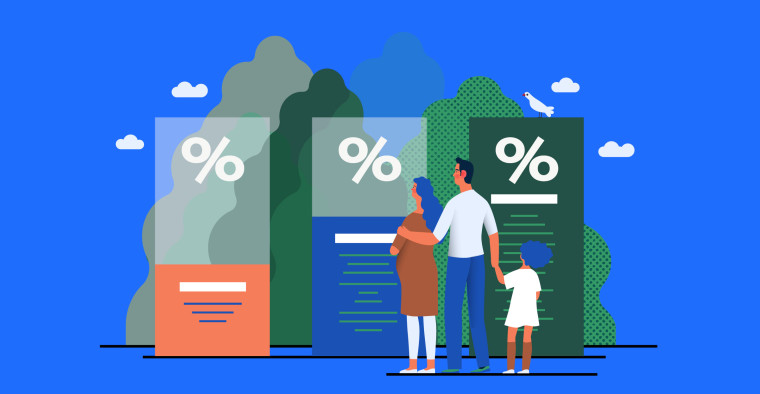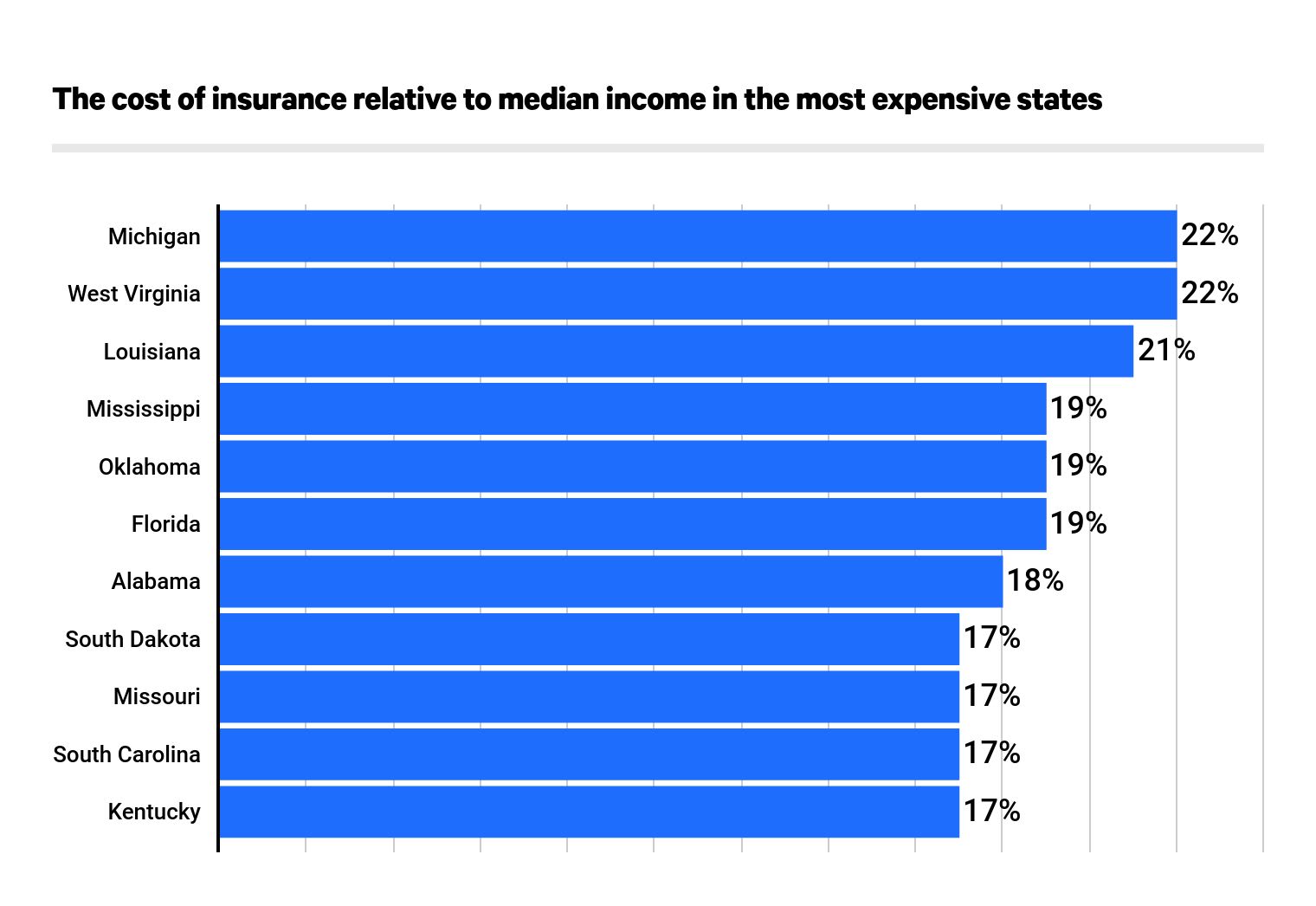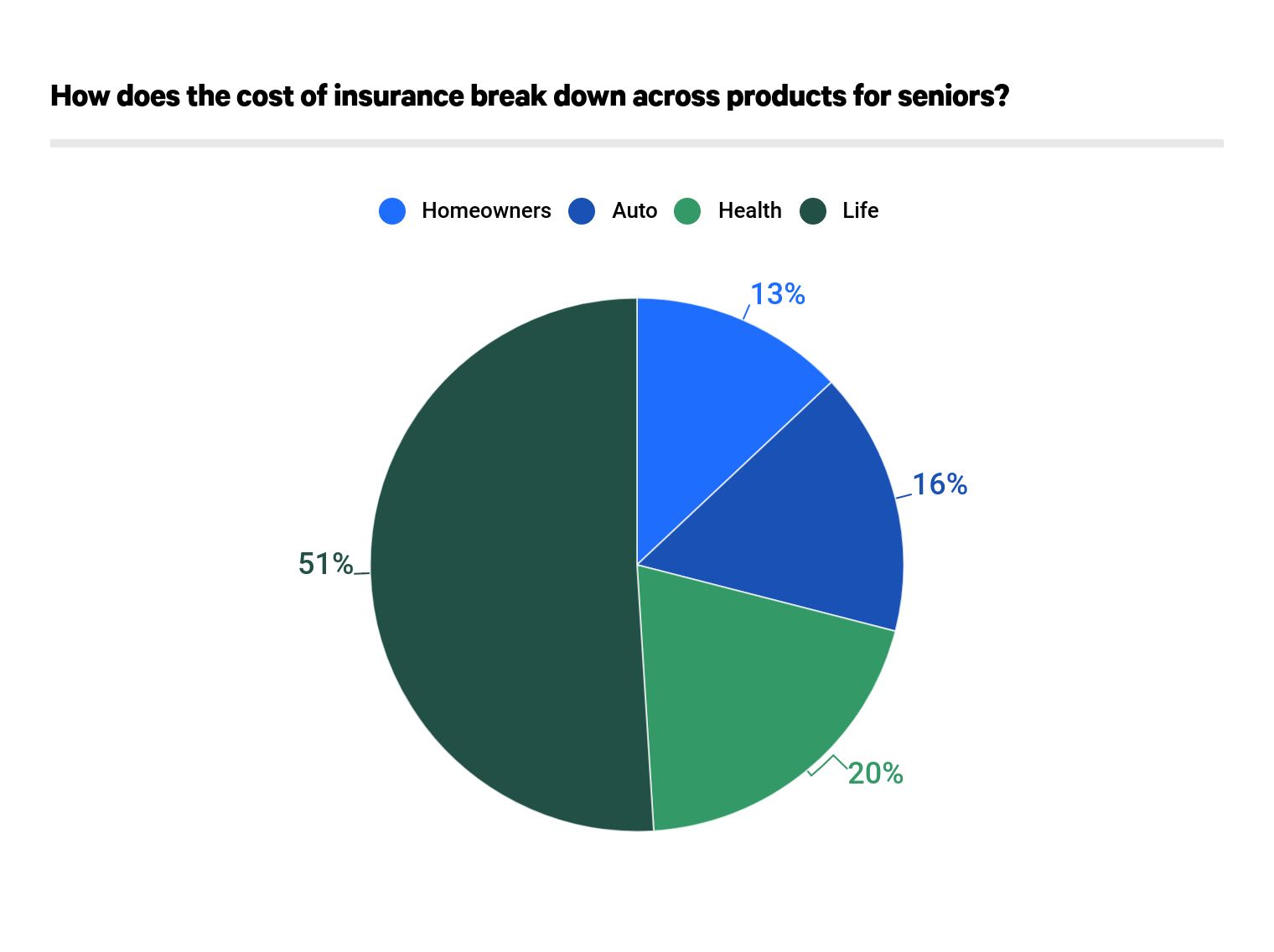Auto Insurance
Most Americans Can Be Fully Insured for 20% of Income

ValuePenguin calculated the cost of four common types of insurance to assess the financial burden that being fully insured poses to most Americans. Based on a comparison of national and statewide median incomes and the cost of car, homeowners/renters, life and health insurance, ValuePenguin determined that most Americans can be fully covered for less than 20% of their income.
For seniors, the cost of coverage is more expensive. Their limited incomes and soaring costs of life insurance mean that being fully covered is ultimately more expensive. Most seniors pay 23% of their income toward insurance.
We also accounted for the cost of flood insurance to see how unaffordable purchasing coverage would be for a typical household. The cost of insurance for those most in danger of flood damage is only slightly higher than it is for most people. After adding a flood insurance policy, the total cost of insurance only increased by 1%, relative to an individual's income.
Key findings
- On average, Americans spend 14% of their income on insurance. This number falls to 12% for renters.
- Residents of Michigan are paying the highest amount of money and the largest share of their income for insurance coverage. In the state, insurance costs most $14,700 per year — 22% of their median income.
- In New Hampshire, insurance amounts to just 8% of residents' income — just over $7,000 per year.
- The cost of being fully insured is higher for seniors, even with cheaper health care premiums. Seniors who own a home spend 23% of their income on their insurance coverage, and renting seniors pay 20%.
- The cost of life insurance can be burdensome to seniors. Yearly life insurance premiums alone take up 13% of seniors' income.
- Although flood insurance isn't widely held, it's not very expensive to tack on. Adding flood insurance costs about 1% of one's income per year but provides coverage that a regular homeowners policy doesn't.

The cost of insurance takes up 14% of a person's income per year, but in some states, the cost can exceed 20%
Americans can expect to pay $10,010 per year on insurance. Renters, we found, pay slightly less for full coverage than homeowners do. Since renters insurance doesn't cover the structure of a rented home, the risk is smaller for insurers and the cost is cheaper for policyholders. Most renters pay 12% of their earnings toward insurance over the course of one year.
Health insurance is the most expensive coverage for most people. Marketplace policies amount to 59% of an individual's insurance expenses, while data from Kaiser Family Foundation (KFF) on average annual premiums (not counting deductibles) for employer-sponsored health insurance suggest that the cost may be higher for those who get coverage through their workplace.
Auto insurance coverage is the second most expensive form of insurance, behind health, but insuring a car costs only a fraction of what most health insurance policies do. Car insurance takes up 16% of a typical person's yearly insurance expenses. Homeowners insurance trails at 14%, and life insurance comes in at 10% of the overall cost of insurance per year.
On average, renters insurance makes up only 3% of an individual's yearly insurance expenses.

Of course, like the cost of insurance, the percentage of income a policyholder can expect to pay for coverage depends on the state. Costs relative to income are the highest in Michigan, West Virginia and Louisiana. In these states, a person can expect to devote more than 20% of their income to insurance costs.
The high cost of car insurance in Michigan is primarily to blame for the state topping the cost-relative-to-income list. In Michigan, full coverage car insurance costs more than $4,000 per year — much higher than in any other state. In West Virginia and Louisiana, exceedingly high health insurance costs — and, in Louisiana's case, an expensive average cost of auto insurance — combine with low median incomes to create a greater insurance burden for most people in those states.
Conversely, in New Hampshire, Washington and Maryland the cost of insurance is less than 10% of the typical person's income. Average health insurance rates in these states tends to be cheaper: Coverage only costs $4,292 per year, which is more than $1,000 cheaper than the national average. Moreover, in these states, the median incomes are all over $85,000 per year.
Rank | State | Median household income | Insurance cost | Percent of income to insurance |
|---|---|---|---|---|
| 1 | Michigan | $65,776 | $14,718 | 22% |
| 2 | West Virginia | $55,592 | $12,322 | 22% |
| 3 | Louisiana | $58,702 | $12,448 | 21% |
| 4 | Mississippi | $50,272 | $9,708 | 19% |
| 5 | Oklahoma | $60,589 | $11,558 | 19% |
| 6 | Florida | $63,007 | $11,853 | 19% |
| 7 | Alabama | $57,424 | $10,382 | 18% |
| 8 | South Dakota | $66,230 | $11,518 | 17% |
| 9 | Missouri | $65,607 | $11,095 | 17% |
| 10 | South Carolina | $61,378 | $10,365 | 17% |
| 11 | Kentucky | $61,212 | $10,270 | 17% |
| 12 | Texas | $67,949 | $11,140 | 16% |
Table is sorted by the percentage of income used for insurance.
Reduced health care costs can't offset seniors' higher life and car insurance premiums
The cost of insurance is comparably higher for seniors than it is for most Americans. The average cost of insurance for seniors amounts to 23% of their annual income. This increase is driven by lower incomes for most people in this age group and higher life and car insurance prices.
Health insurance costs for the typical senior are far lower, thanks to public health insurance (such as Medicare), than the average cost for younger people, which is $5,940. The cost of coverage for seniors is $2,179 per year. Public health insurance costs make up just 20% of a senior's annual insurance budget.
The cost of life insurance is much higher for seniors, compared with younger people. We found that the cost of a term life policy takes up 51% of the amount a typical senior pays for insurance per year. This is more than five times greater than the average cost of life insurance for people ages 25 to 60.

Seniors also face slightly higher car insurance premiums from most companies in most states. The average cost of car insurance for seniors is $1,738 per year, which is $102 more expensive per year than what most people pay. Car insurance accounts for 16% of the overall cost that seniors pay for insurance.
As with younger people, seniors who choose to rent pay less for insurance than their peers who are homeowners: 20% of their income versus 23%.
Rank | State | Median household income (seniors) | Insurance cost (seniors) | Percent of income to insurance (seniors) |
|---|---|---|---|---|
| 1 | Louisiana | $38,662 | $12,263 | 32% |
| 2 | Mississippi | $36,809 | $10,843 | 29% |
| 3 | Michigan | $46,380 | $13,357 | 29% |
| 4 | Kentucky | $40,349 | $11,600 | 29% |
| 5 | Arkansas | $37,863 | $10,632 | 28% |
| 6 | West Virginia | $39,680 | $10,960 | 28% |
| 7 | Oklahoma | $43,501 | $11,817 | 27% |
| 8 | Alabama | $41,644 | $11,261 | 27% |
| 9 | Missouri | $43,329 | $11,453 | 26% |
| 10 | South Carolina | $45,115 | $11,750 | 26% |
| 11 | Montana | $45,579 | $11,557 | 25% |
| 12 | Rhode Island | $49,749 | $12,503 | 25% |
Table is sorted by the percentage of income used for insurance.
Flood insurance may be more affordable for at-risk properties than most people think
The threat of flood damage isn't high for most people. While mortgage lenders require their borrowers to purchase homeowners insurance on their properties, flood insurance is only required by lenders for homes located in areas that the Federal Emergency Management Agency (FEMA) has designated as high risk.
How does flood insurance work? A homeowner will likely purchase flood coverage from the National Flood Insurance Program (NFIP), although private policies are available. A policy provides up to $250,000 of dwelling coverage and $100,000 for the contents of the home. The policyholder pays a separate premium and deductible from their homeowners insurance.
This is why about 6% of owner-occupied homes have flood insurance, according to an analysis of the NFIP's policy data. Additionally, the cost of coverage can be high. The average cost across all states is $734 per year — an unwelcome expense for homeowners whose houses aren't necessarily in the most high-risk category.
However, the cost for many people may not be as onerous as it appears. Purchasing a flood insurance policy results in a 1% increase in the overall cost of insurance for most people. In the most expensive state for flood insurance, Vermont (where just 1.4% have policies), adding flood insurance to a mid-risk home results in a 4% increase to the overall cost of coverage during a single year.
Rank | State | Percentage of income for insurance with flood coverage | Increase in insurance costs relative to income |
|---|---|---|---|
| 1 | Alabama | 19% | 1% |
| 2 | Alaska | 14% | 1% |
| 3 | Arizona | 17% | 1% |
| 4 | Arkansas | 17% | 2% |
| 5 | California | 14% | 1% |
| 6 | Colorado | 12% | 1% |
| 7 | Connecticut | 15% | 2% |
| 8 | Delaware | 15% | 1% |
| 9 | Florida | 20% | 1% |
| 10 | Georgia | 16% | 1% |
| 11 | Hawaii | 11% | 1% |
| 12 | Idaho | 14% | 1% |
Asterisks signify the states with the highest ratio of flood insurance policies to owner-occupied homes.
Methodology
ValuePenguin identified the median incomes for seniors older than 65 and people ages 25–44 using the United States Census Bureau's 2019 American Community Survey. We found the combined cost of insurance for the following forms of coverage:
- Full coverage auto insurance
- Homeowners or renters insurance
- Marketplace health insurance
- Term life insurance (20 years)
For our senior health care analysis, our profile had Medicare Parts A, B and D. For Part B, whose costs are determined by income, our profile included only the base premium. For Part D, our profile would have only had to pay $33.06, the minimum base premium, according to the Centers for Medicare and Medicaid Services.
To find the cost of auto insurance for most people, we found rates across every ZIP code in each state for a 30-year-old driver and a 65-year-old driver with no accident history and average credit.
Our homeowners insurance rates reflect the cost to insure a median-value home in each state.
Our life insurance refers to the average cost of coverage for a 20-year term life policy for someone younger than 65. For seniors, a separate rate was used.
ValuePenguin's analysis used insurance rate data from Quadrant Information Services. These rates were publicly sourced from insurer filings and should be used for comparative purposes only. Your own quotes may be different.
